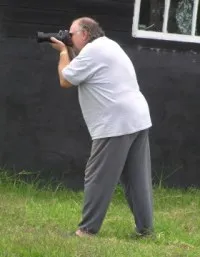Maria Vega, The white sparrow Panama's rarest bird?
Maria Vega is panama's rarest bird, this albino sparroe has never been seen before

Maria Vega is panama's rarest bird, this albino sparroe has never been seen before

It is small, barely 5 and ½ inches long, it is not brightly colored, has no distinctive song yet the Maria Vega may be the rarest bird on this planet. It belongs to the humble sparrow family, specifically the Rufous Collared Sparrow family, the Latin name is Zonotrichia Capensis. What makes this little bird so special is its color – almost completely white. Through some odd quirk of genetics this bird is unlike the color of any of its species. If it does mate then the chances are overwhelmingly that its off spring will not be white – they will revert to being plain old sparrow-colored. So the Maria Vega is truly unique because it may be the only bird of this type and color in the entire world.

Named after local amateur Panamanian ornithologist Maria Vega, this bird was spotted in the highlands of western Panama near the town of Volcan.
Panama has a rich and varied bird population, according to the book, “Birds of Panama,” there are about 883, different types. There are about 300 types in the Chiriqui area alone. The Chiriqui highlands boasts having the worlds most exotic and beautiful rare bird – the resplendant quetzal.


It was March the 5th 2008. A warm sunny day when local birder Maria Vega set out to visit Volcan’s volcanic lagoons. This area is rich in birds and the many multicolored species make a day’s outing always rewarding. When Maria passed a small field close to the towns airport, she caught some movement out of the corner of her eye. Two sparrows gadding about in a field on a summer’s day, is a common enough sight. But when one of the pair is white – that is unusual.

Her discovery remained a secret until March 20th when she was in conversation with her Friend Claudia Flores. Claudia is a local tour guide and asked if I would write a story on this. When we arrived at the location, I realized we were across the road from my friend Erik Westra’s house – I knew Erik had a new expensive digital camera with a long telephoto lens. Within minutes he was in the field shooting away. When the pictures were emailed to me I was stunned. The resolution and depth of field was wonderful. He had taken some pictures that could add a chapter to local bird history.

As I was editing this page for the Internet, something caught my eye. When Erik and I were shooting, I was at a slightly different location, fifty feet away. We assumed we were photographing the same white bird. But comparing the two sets of pictures it became apparent there were two white sparrows and not one. Even for someone like myself that has little or no knowledge of things avian, the significance was clear. Instead of having a single, genetic anomaly, we may have a new subspecies of bird.

COMPARE.This bird’s wings with others shown. Body seems thinner and colors not so defined. Is this a second white sparrow?
Maria came to my house two days later and looked at the pictures taken by myself and Erik Westra. I asked her to compare them and look for differences. She felt sure the second bird is a female. She says the males are much brighter and larger. Are we sure we have a new subspecies? Before we make that statement we need one more picture. Erik’s home is just a few steps away from where the birds congregate. If he manages to take a single picture with two, white sparrows in it, then we have proof positive. The Maria Vega will be Panama’s and the world’s newest and possibly rarest species of bird.
If you are a member of any bird watching society or would like further details of this story, please email me: